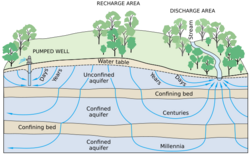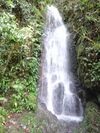Earth:Groundwater recharge
Groundwater recharge or deep drainage or deep percolation is a hydrologic process, where water moves downward from surface water to groundwater. Recharge is the primary method through which water enters an aquifer. This process usually occurs in the vadose zone below plant roots and is often expressed as a flux to the water table surface. Groundwater recharge also encompasses water moving away from the water table farther into the saturated zone.[1] Recharge occurs both naturally (through the water cycle) and through anthropogenic processes (i.e., "artificial groundwater recharge"), where rainwater and or reclaimed water is routed to the subsurface.
The most common methods to estimate recharge rates are: chloride mass balance (CMB); soil physics methods; environmental and isotopic tracers; groundwater-level fluctuation methods; water balance (WB) methods (including groundwater models (GMs)); and the estimation of baseflow (BF) to rivers.[2]
Processes
Diffused or focused mechanisms
Groundwater recharge can occur through diffuse or focused mechanisms. Diffuse recharge occurs when precipitation infiltrates through the soil to the water table, and is by definition distributed over large areas. Focused recharge occurs where water leaks from surface water sources (rivers, lakes, wadis, wetlands) or land surface depressions, and generally becomes more dominant with aridity.[2]
Natural recharge
Water is recharged naturally by rain and snow melt and to a smaller extent by surface water (rivers and lakes). Recharge may be impeded somewhat by human activities including paving, development, or logging. These activities can result in loss of topsoil resulting in reduced water infiltration, enhanced surface runoff and reduction in recharge. Use of groundwater, especially for irrigation, may also lower the water tables. Groundwater recharge is an important process for sustainable groundwater management, since the volume-rate abstracted from an aquifer in the long term should be less than or equal to the volume-rate that is recharged.
Recharge can help move excess salts that accumulate in the root zone to deeper soil layers, or into the groundwater system. Tree roots increase water saturation into groundwater reducing water runoff.[3] Flooding temporarily increases river bed permeability by moving clay soils downstream, and this increases aquifer recharge.[4]
Wetlands
Wetlands help maintain the level of the water table and exert control on the hydraulic head.[5][6] This provides force for groundwater recharge and discharge to other waters as well. The extent of groundwater recharge by a wetland is dependent upon soil, vegetation, site, perimeter to volume ratio, and water table gradient.[7][8] Groundwater recharge occurs through mineral soils found primarily around the edges of wetlands.[9] The soil under most wetlands is relatively impermeable. A high perimeter to volume ratio, such as in small wetlands, means that the surface area through which water can infiltrate into the groundwater is high.[8] Groundwater recharge is typical in small wetlands such as prairie potholes, which can contribute significantly to recharge of regional groundwater resources.[8] Researchers have discovered groundwater recharge of up to 20% of wetland volume per season.[8]
Artificial groundwater recharge
Managed aquifer recharge (MAR) strategies to augment freshwater availability include streambed channel modification, bank filtration, water spreading and recharge wells.[10]:110
Artificial groundwater recharge is becoming increasingly important in India, where over-pumping of groundwater by farmers has led to underground resources becoming depleted. In 2007, on the recommendations of the International Water Management Institute, the Indian government allocated ₹1,800 crore (equivalent to ₹44 billion or US$610 million in 2019) to fund dug-well recharge projects (a dug-well is a wide, shallow well, often lined with concrete) in 100 districts within seven states where water stored in hard-rock aquifers had been over-exploited. Another environmental issue is the disposal of waste through the water flux such as dairy farms, industrial, and urban runoff.
Pollution in stormwater run-off collects in retention basins. Concentrating degradable contaminants can accelerate biodegradation. However, where and when water tables are high this affects appropriate design of detention ponds, retention ponds and rain gardens.
Depression-focused recharge
If water falls uniformly over a field such that field capacity of the soil is not exceeded, then negligible water percolates to groundwater. If instead water puddles in low-lying areas, the same water volume concentrated over a smaller area may exceed field capacity resulting in water that percolates down to recharge groundwater. The larger the relative contributing runoff area is, the more focused infiltration is. The recurring process of water that falls relatively uniformly over an area, flowing to groundwater selectively under surface depressions is depression focused recharge. Water tables rise under such depressions.
Depression focused groundwater recharge can be very important in arid regions. More rain events are capable of contributing to groundwater supply.
Depression focused groundwater recharge also profoundly effects contaminant transport into groundwater. This is of great concern in regions with karst geological formations because water can eventually dissolve tunnels all the way to aquifers, or otherwise disconnected streams. This extreme form of preferential flow, accelerates the transport of contaminants and the erosion of such tunnels. In this way depressions intended to trap runoff water—before it flows to vulnerable water resources—can connect underground over time. Cavitation of surfaces above into the tunnels, results in potholes or caves.
Deeper ponding exerts pressure that forces water into the ground faster. Faster flow dislodges contaminants otherwise adsorbed on soil and carries them along. This can carry pollution directly to the raised water table below and into the groundwater supply. Thus the quality of water collecting in infiltration basins is of special concern.
Estimation methods
Rates of groundwater recharge are difficult to quantify.[11][2] This is because other related processes, such as evaporation, transpiration (or evapotranspiration) and infiltration processes must first be measured or estimated to determine the balance. There are no widely applicable method available that can directly and accurately quantify the volume of rainwater that reaches the water table.[2]
The most common methods to estimate recharge rates are: chloride mass balance (CMB); soil physics methods; environmental and isotopic tracers; groundwater-level fluctuation methods; water balance (WB) methods (including groundwater models (GMs)); and the estimation of baseflow (BF) to rivers.[2]
Regional, continental and global estimates of recharge commonly derive from global hydrological models.[2]
Physical
Physical methods use the principles of soil physics to estimate recharge. The direct physical methods are those that attempt to actually measure the volume of water passing below the root zone. Indirect physical methods rely on the measurement or estimation of soil physical parameters, which along with soil physical principles, can be used to estimate the potential or actual recharge. After months without rain the level of the rivers under humid climate is low and represents solely drained groundwater. Thus, the recharge can be calculated from this base flow if the catchment area is already known.
Chemical
Chemical methods use the presence of relatively inert water-soluble substances, such as an isotopic tracer[12][13][14] or chloride,[15] moving through the soil, as deep drainage occurs.
Numerical models
Recharge can be estimated using numerical methods, using such codes as Hydrologic Evaluation of Landfill Performance, UNSAT-H, SHAW (short form of Simultaneous Heat and Water Transfer model), WEAP, and MIKE SHE. The 1D-program HYDRUS1D is available online. The codes generally use climate and soil data to arrive at a recharge estimate and use the Richards equation in some form to model groundwater flow in the vadose zone.
Factors affecting groundwater recharge
Climate change
Urbanization
Further implications of groundwater recharge are a consequence of urbanization. Research shows that the recharge rate can be up to ten times higher[16] in urban areas compared to rural regions. This is explained through the vast water supply and sewage networks supported in urban regions in which rural areas are not likely to obtain. Recharge in rural areas is heavily supported by precipitation[16] and this is opposite for urban areas. Road networks and infrastructure within cities prevents surface water from percolating into the soil, resulting in most surface runoff entering storm drains for local water supply. As urban development continues to spread across various regions, rates of groundwater recharge will increase relative to the existing rates of the previous rural region. A consequence of sudden influxes in groundwater recharge includes flash flooding.[17] The ecosystem will have to adjust to the elevated groundwater surplus due to groundwater recharge rates. Additionally, road networks are less permeable compared to soil, resulting in higher amounts of surface runoff. Therefore, urbanization increases the rate of groundwater recharge and reduces infiltration,[17] resulting in flash floods as the local ecosystem accommodates changes to the surrounding environment.
Adverse factors
See also
- Aquifer storage and recovery
- Contour trenching
- Depression focused recharge
- Dry well
- Groundwater model
- Groundwater remediation
- Hydrology (agriculture)
- Infiltration (hydrology)
- International trade and water
- Peak water
- Rainwater harvesting
- Soil salinity control by subsurface drainage
- Subsurface dyke
- Watertable control
References
- ↑ Freeze, R.A.; Cherry, J.A. (1979). Groundwater. Prentice-Hall. ISBN 978-0-13-365312-0. OCLC 643719314. https://archive.org/details/groundwater00free. Accessed from: http://hydrogeologistswithoutborders.org/wordpress/1979-english/
- ↑ 2.0 2.1 2.2 2.3 2.4 2.5 MacDonald, Alan M; Lark, R Murray; Taylor, Richard G; Abiye, Tamiru; Fallas, Helen C; Favreau, Guillaume; Goni, Ibrahim B; Kebede, Seifu et al. (2021-03-01). "Mapping groundwater recharge in Africa from ground observations and implications for water security". Environmental Research Letters 16 (3): 034012. doi:10.1088/1748-9326/abd661. ISSN 1748-9326. Bibcode: 2021ERL....16c4012M.
 Text was copied from this source, which is available under a Creative Commons Attribution 4.0 International License
Text was copied from this source, which is available under a Creative Commons Attribution 4.0 International License
- ↑ "Urban Trees Enhance Water Infiltration". Fisher, Madeline. The American Society of Agronomy. November 17, 2008. https://www.agronomy.org/news-media/releases/2008/1117/221/.
- ↑ "Major floods recharge aquifers". University of New South Wales Science. January 24, 2011. http://www.science.unsw.edu.au/news/major-floods-recharge-aquifers/.
- ↑ O'Brien 1988
- ↑ Winter, T.C. (1988). "A conceptual framework for assessing cumulative impacts on the hydrology of nontidal wetlands". Environmental Management 12 (5): 605–620. doi:10.1007/BF01867539. Bibcode: 1988EnMan..12..605W. https://lab.jonesctr.org/wp-content/uploads/2021/06/4_impacts_on_hydrology.pdf.
- ↑ Carter, V.; Novitzki, R.P. (1988). "Some Comments on the Relation between Ground Water and Wetlands". The Ecology and Management of Wetlands. 1. Springer. pp. 68–86. doi:10.1007/978-1-4684-8378-9_7. ISBN 978-1-4684-8378-9.
- ↑ 8.0 8.1 8.2 8.3 Weller, M.W. (1994). Freshwater Marshes: Ecology and Wildlife Management (3rd ed.). University of Minnesota Press. ISBN 978-0-8166-8574-5. OCLC 476093538. https://books.google.com/books?id=Uf1VTku_ID8C&pg=PR9.
- ↑ Verry, E.S.; Timmons, D.R. (1982). "Waterborne nutrient flow through an upland‐peatland watershed in Minnesota". Ecology 63 (5): 1456–67. doi:10.2307/1938872. Bibcode: 1982Ecol...63.1456V. https://www.nrs.fs.usda.gov/pubs/jrnl/1982/nc_1982_verry_001.pdf.
- ↑ United Nations (2022) The United Nations World Water Development Report 2022: Groundwater: Making the invisible visible. UNESCO, Paris
 Text was copied from this source, which is available under a Creative Commons Attribution 3.0 International License
Text was copied from this source, which is available under a Creative Commons Attribution 3.0 International License
- ↑ Reilly, Thomas E.; LaBaugh, James W.; Healy, Richard W.; Alley, William M. (2002-06-14). "Flow and Storage in Groundwater Systems". Science 296 (5575): 1985–90. doi:10.1126/science.1067123. PMID 12065826. Bibcode: 2002Sci...296.1985A.
- ↑ Gat, J. R. (May 1996). "Oxygen and Hydrogen Isotopes in the Hydrologic Cycle" (in en). Annual Review of Earth and Planetary Sciences 24 (1): 225–262. doi:10.1146/annurev.earth.24.1.225. ISSN 0084-6597. Bibcode: 1996AREPS..24..225G. https://www.annualreviews.org/doi/10.1146/annurev.earth.24.1.225.
- ↑ Jasechko, Scott (September 2019). "Global Isotope Hydrogeology―Review" (in en). Reviews of Geophysics 57 (3): 835–965. doi:10.1029/2018RG000627. ISSN 8755-1209. Bibcode: 2019RvGeo..57..835J. https://onlinelibrary.wiley.com/doi/abs/10.1029/2018RG000627.
- ↑ Stahl, Mason O.; Gehring, Jaclyn; Jameel, Yusuf (2020-07-30). "Isotopic variation in groundwater across the conterminous United States – Insight into hydrologic processes" (in en). Hydrological Processes 34 (16): 3506–3523. doi:10.1002/hyp.13832. ISSN 0885-6087. Bibcode: 2020HyPr...34.3506S. https://onlinelibrary.wiley.com/doi/10.1002/hyp.13832.
- ↑ Allison, G.B.; Hughes, M.W. (1978). "The use of environmental chloride and tritium to estimate total recharge to an unconfined aquifer". Australian Journal of Soil Research 16 (2): 181–195. doi:10.1071/SR9780181.
- ↑ 16.0 16.1 "Groundwater depletion". United States Geological Survey. 2016-12-09. https://water.usgs.gov/edu/gwdepletion.html.
- ↑ 17.0 17.1 "Effects of Urban Development on Floods". https://pubs.usgs.gov/fs/fs07603/.
 |




